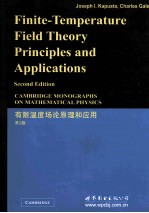

有限温度场论原理和应用 原书第2版PDF电子书下载
- 电子书积分:14 积分如何计算积分?
- 作 者:(美)卡普斯塔著
- 出 版 社:北京:世界图书北京出版公司
- 出版年份:2011
- ISBN:9787510029660
- 页数:428 页
1 Review of quantum statistical mechanics 1
1.1 Ensembles 1
1.2 One bosonic degree of freedom 3
1.3 One fermionic-degree of freedom 5
1.4 Noninteracting gases 6
1.5 Exercises 10
Bibliography 11
2 Functional integral representation of the partition function 12
2.1 Transition amplitude for bosons 12
2.2 Partition function for bosons 15
2.3 Neutral scalar field 16
2.4 Bose-Einstein condensation 19
2.5 Fermions 23
2.6 Remarks on functional integrals 30
2.7 Exercises 31
Reference 31
Bibliography 31
3 Interactions and diagrammatic techniques 33
3.1 Perturbation expansion 33
3.2 Diagrammatic rules for λφ4 theory 34
3.3 Propagators 38
3.4 First-order corrections to ∏ and ln Z 41
3.5 Summation of infrared divergences 45
3.6 Yukawa theory 47
3.7 Remarks on real time perturbation theory 51
3.8 Exercises 53
References 54
Bibliography 54
4 Renormalization 55
4.1 Renormalizing λφ4 theory 55
4.2 Renormalization group 57
4.3 Regularization schemes 60
4.4 Application to the partition function 61
4.5 Exercises 63
References 63
Bibliography 63
5 Quantum electrodynamics 64
5.1 Quantizing the electromagnetic field 64
5.2 Blackbody radiation 68
5.3 Diagrammatic expansion 70
5.4 Photon self-energy 71
5.5 Loop corrections to ln Z 74
5.6 Exercises 82
References 83
Bibliography 83
6 Linear response theory 84
6.1 Linear response to an external field 84
6.2 Lehmann representation 87
6.3 Screening of static electric fields 90
6.4 Screening of a point charge 94
6.5 Exact formula for screening length in QED 97
6.6 Collective excitations 100
6.7 Photon dispersion relation 101
6.8 Electron dispersion relation 105
6.9 Kubo formulae for viscosities and conductivities 107
6.10 Exercises 114
References 115
Bibliography 115
7 Spontaneous symmetry breaking and restoration 117
7.1 Charged scalar field with negative mass-squared 117
7.2 Goldstone's theorem 123
7.3 Loop corrections 125
7.4 Higgs model 130
7.5 Exercises 133
References 133
Bibliography 134
8 Quantum chromodynamics 135
8.1 Quarks and gluons 136
8.2 Asymptotic freedom 139
8.3 Perturbative evaluation of partition function 146
8.4 Higher orders at finite temperature 149
8.5 Gluon propagator and linear response 152
8.6 Instantons 156
8.7 Infrared problems 161
8.8 Strange quark matter 163
8.9 Color superconductivity 166
8.10 Exercises 174
References 175
Bibliography 176
9 Resummation and hard thermal loops 177
9.1 Isolating the hard thermal loop contribution 179
9.2 Hard thermal loops and Ward identities 185
9.3 Hard thermal loops and effective perturbation theory 187
9.4 Spectral densities 188
9.5 Kinetic theory 189
9.6 Transport coefficients 193
9.7 Exercises 194
References 194
10 Lattice gauge theory 195
10.1 Abelian gauge theory 196
10.2 Nonabelian gauge theory 202
10.3 Fermions 203
10.4 Phase transitions in pure gauge theory 206
10.5 Lattice QCD 212
10.6 Exercises 217
References 217
Bibliography 218
11 Dense nuclear matter 219
11.1 Walecka model 220
11.2 Loop corrections 226
11.3 Three-and four-body interactions 232
11.4 Liquid-gas phase transition 233
11.5 Summary 236
11.6 Exercises 237
References 238
Bibliography 239
12 Hot hadronic matter 240
12.1 Chiral perturbation theory 240
12.2 Self-energy from experimental data 248
12.3 Weinberg sum rules 254
12.4 Linear and nonlinear σ models 265
12.5 Exercises 287
References 287
Bibliography 288
13 Nucleation theory 289
13.1 Quantum nucleation 290
13.2 Classical nucleation 294
13.3 Nonrelativistic thermal nucleation 296
13.4 Relativistic thermal nucleation 298
13.5 Black hole nucleation 313
13.6 Exercises 315
References 315
Bibliography 316
14 Heavy ion collisions 317
14.1 Bjorken model 318
14.2 The statistical model of particle production 324
14.3 The emission of electromagnetic radiation 328
14.4 Photon production in high-energy heavy ion collisions 331
14.5 Dilepton production 339
14.6 J/ψsuppression 345
14.7 Strangeness production 350
14.8 Exercises 356
References 358
Bibliography 359
15 Weak interactions 361
15.1 Glashow-Weinberg-Salam model 361
15.2 Symmetry restoration in mean field approximation 365
15.3 Symmetry restoration in perturbation theory 369
15.4 Symmetry restoration in lattice theory 374
15.5 Exercises 377
References 377
Bibliography 378
16 Astrophysics and cosmology 379
16.1 White dwarf stars 380
16.2 Neutron stars 382
16.3 Neutrino emissivity 388
16.4 Cosmological QCD phase transition 394
16.5 Electroweak phase transition and baryogenesis 402
16.6 Decay of a heavy particle 408
16.7 Exercises 410
References 411
Bibliography 412
Conclusion 413
Appendix 417
A1.1 Thermodynamic relations 417
A1.2 Microcanonical and canonical ensembles 418
A1.3 High-temperature expansions 421
A1.4 Expansion in the degeneracy 423
References 424
Index 425
- 《钒产业技术及应用》高峰,彭清静,华骏主编 2019
- 《现代水泥技术发展与应用论文集》天津水泥工业设计研究院有限公司编 2019
- 《英汉翻译理论的多维阐释及应用剖析》常瑞娟著 2019
- 《数据库技术与应用 Access 2010 微课版 第2版》刘卫国主编 2020
- 《区块链DAPP开发入门、代码实现、场景应用》李万胜著 2019
- 《虚拟流域环境理论技术研究与应用》冶运涛蒋云钟梁犁丽曹引等编著 2019
- 《当代翻译美学的理论诠释与应用解读》宁建庚著 2019
- 《第一性原理方法及应用》李青坤著 2019
- 《计算机组成原理解题参考 第7版》张基温 2017
- 《高等院校保险学专业系列教材 保险学原理与实务》林佳依责任编辑;(中国)牟晓伟,李彤宇 2019
- 《SQL与关系数据库理论》(美)戴特(C.J.Date) 2019
- 《魔法销售台词》(美)埃尔默·惠勒著 2019
- 《看漫画学钢琴 技巧 3》高宁译;(日)川崎美雪 2019
- 《优势谈判 15周年经典版》(美)罗杰·道森 2018
- 《社会学与人类生活 社会问题解析 第11版》(美)James M. Henslin(詹姆斯·M. 汉斯林) 2019
- 《海明威书信集:1917-1961 下》(美)海明威(Ernest Hemingway)著;潘小松译 2019
- 《迁徙 默温自选诗集 上》(美)W.S.默温著;伽禾译 2020
- 《上帝的孤独者 下 托马斯·沃尔夫短篇小说集》(美)托马斯·沃尔夫著;刘积源译 2017
- 《巴黎永远没个完》(美)海明威著 2017
- 《剑桥国际英语写作教程 段落写作》(美)吉尔·辛格尔顿(Jill Shingleton)编著 2019
- 《TED说话的力量 世界优秀演讲者的口才秘诀》(坦桑)阿卡什·P.卡里亚著 2019
- 《小手画出大世界 恐龙世界》登亚编绘 2008
- 《近代世界史文献丛编 19》王强主编 2017
- 《课堂上听不到的历史传奇 世界政治军事名人 初中版》顾跃忠等编著 2015
- 《指向核心素养 北京十一学校名师教学设计 英语 七年级 上 配人教版》周志英总主编 2019
- 《365奇趣英语乐园 世界民间故事》爱思得图书国际企业 2018
- 《近代世界史文献丛编 36》王强主编 2017
- 《北京生态环境保护》《北京环境保护丛书》编委会编著 2018
- 《近代世界史文献丛编 11》王强主编 2017
- 《近代世界史文献丛编 18》王强主编 2017
